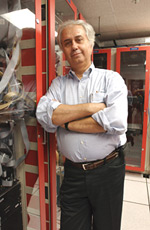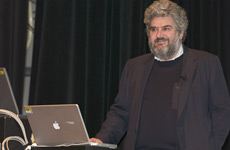| Tuesday, October 14, 2008 |
| Subscribe | Contact Fermilab Today | Archive | Classifieds |
CDF physicists Ristori and Menzione awarded Panofsky Prize for establishment and use of silicon detectors in a hadron colliderWhen Italian physicist Aldo Menzione recently received a phone call at 2 a.m., he expected bad news. But the INFN-Pisa scientist's wakeup call turned out to be the announcement of his selection, along with his colleague, Fermilab guest scientist Luciano Ristori (INFN-Pisa), as a winner of the prestigious 2009 W.K.H. Panofsky Prize in Experimental Physics. The two CDF collaborators won for their leading role in the establishment and use of silicon tracking detectors at a hadron collider. Menzione and Ristori’s vision for silicon detectors and their application are now integral to CDF and have been adapted for other particle detectors worldwide. Their insight resulted in a paradigm shift; most detector designs now routinely incorporate these ideas. “This is well-deserved,” said CDF co-spokesperson Jacobo Konigsberg. “These guys had great foresight. They attempted and succeeded in projects that are clear in merit and significance.” Awarded by the American Physical Society, the Panofsky Prize is considered one of the highest honors a physicist can receive. This is the first Panofsky Prize awarded to CDF physicists for their contributions to the CDF experiment. “We were thrilled,” said CDF co-spokesperson Rob Roser about learning of this recognition for CDF. “There are many things about CDF that we feel are innovative. It is nice to be recognized.” Menzione and Ristori’s innovation pushed the envelope of particle physics technology, allowing breakthrough discoveries. Although their detector concepts are now widely used, scientists weren’t originally receptive to using silicon in a hadron collider environment. “Silicon detectors at that time were in their infancy,” Ristori said. “They had been used in some fixed-target experiments but they were small, hard to operate and very delicate.” Menzione proposed and established CDF’s Silicon Vertex Detector (SVX). The SVX sits close to the beam pipe and allows scientists to reconstruct events to lead back to their origin. “People weren’t sure that the silicon detector would work, but it became fundamental at hadron colliders. The SVX is the most costly part, it has the most number of channels, it is the riskiest and is the hardest to build,” Konigsberg said. “It took a large and dedicated team of CDF collaborators from institutions around the world to turn this idea into a working detector.” Most physics research conducted in the CDF experiment relies on the SVX. Konigsberg and Roser called the SVX instrumental in the discovery of the top quark in 1995. Ristori helped to further the range of possible discoveries in the experiment with the establishment of the Silicon Vertex Trigger (SVT). The SVT identifies tracks coming from the decay of long-lived particles containing b and c quarks. It does that in a time short enough to activate the trigger and record interesting events for permanent storage. The capability to separate b and c decays at trigger level is vital to the CDF program. Many important results published by CDF in the last few years, including the measurement of the oscillation frequency of the Bs, were made possible by the SVT. “The award gives me personally a great feeling of fulfillment,” Ristori said. “I think it is a great recognition of the role that Italians have played in CDF since the beginning.” Ristori and Menzione will accept their awards during the May 2009 APS meeting in Denver, Colorado. Established in 1985 to honor the former director of the Stanford Linear Accelerator Center, the W. K. H. Panofsky Prize comes with a $10,000 cash prize and a citation-bearing certificate. --Rhianna Wisniewski |

